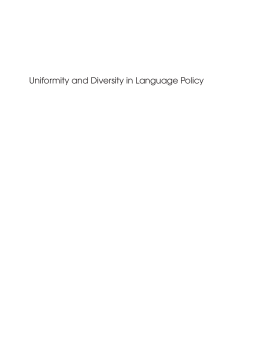
Additional Information
Book Details
Abstract
This book brings together current research by leading international scholars on the often contentious nature of language policies and their practical outcomes in North America, Australia and Europe. It presents a range of perspectives from which to engage with a variety of pressing issues raised by multilingualism, multiculturalism, immigration, exclusion, and identity. A recurrent theme is that of tension and conflict: between uniformity and diversity, between official policies and real day-to-day life experiences, but also between policies in schools and the corporate world and their implementation. Several chapters present research about language policy issues that has previously not been fully or easily available to an English-language audience. Many of the chapters also provide up-to-date analyses of language policy issues in particular regions or countries, focusing on recent developments.
The book is a valuable addition to the literature on language policy both at the macro and the micro levels. It serves to bring to one’s notice that linguistic rights are increasingly being acknowledged both in the recognition of weaker languages by the state and of using them in schooling and other domains. It also shows an increasing democratization in culture through the promotion of language norms associated with solidarity and non-hierarchical behavior than was the case before.
Tariq Rahman, Beaconhouse National University, Pakistan
Catrin Norrby is Professor of Scandinavian Languages at Stockholm University, Sweden, and Principal Fellow in the School of Languages and Linguistics at The University of Melbourne. She has published several monographs, edited books, textbooks and articles in the areas of sociolinguistics, discourse analysis and second language acquisition. She is co-author of Language and Human Relations: Styles of Address in Contemporary Language (2009).
John Hajek is Professor of Italian and Director of the Research Unit for Multilingualism and Cross-cultural Communication (RUMACCC) in the School of Languages and Linguistics at The University of Melbourne. He is also founding president of the Languages and Cultures Network for Australian Universities (LCNAU).
Uniformity and Diversity in Language Policy is a welcome addition to the study of language policy and planning with a balanced mixture of contributions that consolidate, elaborate and innovate research on well-known as well as recently emerging language problems and linguistic practices.
The quality of the studies in this volume testifies to the fact the authors are experts with deep insight into the issues and locations they describe. Although the chapters are very diverse in geography and focus, they concern a number of topics of general interest, such as citizenship, nation building, the situation of indigenous populations, minority language education, economic interests in language policy, efforts to change communicative norms, etc.…The book under review is a useful contribution to our understanding of the historical development and present contexts of language policy creation and implementation at various levels, from supranational to local, in the Western world. Readers will very likely find in it something which will complement their knowledge of the locations or aspects of language policy they are interested in. Thanks to the book's relatively wide geographical coverage and its attention to the outcomes of language policies cast against historical and present-day backgrounds, persons working in language policy can find here inspiration for their work on language issues in their own countries.
This book is an important instalment in language planning literature serving to expand the domains and kinds of language policy described, the modes in which it operates, the players involved and the purposes they pursue. Language policy invariably involves politics and tension, a focus which unifies the diverse chapters of this volume allowing comparison, contrast and reflection across sites, settings and histories.
Table of Contents
| Section Title | Page | Action | Price |
|---|---|---|---|
| Contents | v | ||
| Contributors | vii | ||
| Acknowledgements | xi | ||
| General Introduction | xiii | ||
| Part 1 | 1 | ||
| Introduction to Part 1 | 3 | ||
| Chapter 1 | 7 | ||
| Chapter 2 | 22 | ||
| Chapter 3 | 37 | ||
| Chapter 4 | 53 | ||
| Chapter 5 | 68 | ||
| Part 2 | 87 | ||
| Introduction to Part 2 | 89 | ||
| Chapter 6 | 93 | ||
| Chapter 7 | 109 | ||
| Chapter 8 | 126 | ||
| Chapter 9 | 141 | ||
| Chapter 10 | 157 | ||
| Part 3 | 175 | ||
| Introduction to Part 3 | 177 | ||
| Chapter 11 | 180 | ||
| Chapter 12 | 195 | ||
| Chapter 13 | 210 | ||
| Chapter 14 | 226 | ||
| Chapter 15 | 242 | ||
| Chapter 16 | 258 |
